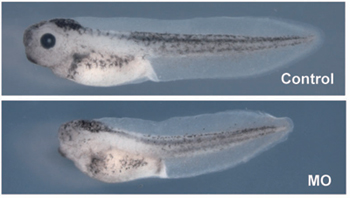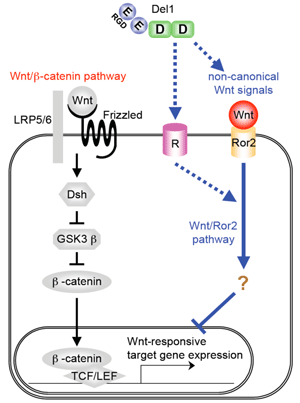| RIKEN Center for Developmental Biology (CDB) 2-2-3 Minatojima minamimachi, Chuo-ku, Kobe 650-0047, Japan |
September 20, 2010 – In amphibians, the anterior-posterior axis develops headfirst, with forebrain representing the default fate and more caudal tissues emerging secondarily through the action of multiple posteriorizing factors. These factors play an instructive role in specifying the fates that targeted regions adopt, but also work to suppress the development of anterior structures. It is this combination of inhibition and induction that sets up the gradient of tissue identities along the A-P axis. Of the many known factors of this kind, Wnt stands out for its potent caudalizing effect, but what prevents such posterior factors from transforming anterior structures as well?
That question has been at least partially answered in a new study by Akira Takai and others in the Laboratory for Organogenesis and Neurogenesis (Yoshiki Sasai, Group Director), which showed that the secreted protein Del1 inhibits Wnt signaling in embryonic head regions in the African clawed frog, Xenopus laevis. In a report published in the journal Development, the group describes how this extracellular matrix protein staves off its posteriorizing effects through interaction with a downstream component of the canonical Wnt pathway. Del1 was already well known to the group from previous work in which they had shown that the protein inhibited BMP, a major ventralizing factor that works in the establishment of the dorsal-ventral axis. So they were intrigued when they found that injection of Del1 mRNA into a different part of the early embryo resulted in a phenotype with an oversized head and eyes. To validate that finding, they tested for Del1 effect in artificially induced secondary axes, which can be triggered by injection of anti-BMP factors, such as Chd. Such axes rarely develop anterior structures, but when Del1 was coinjected with Chd, eye tissue formed, indicating that misexpresion of Del1 promotes anteriorization. The converse was also true – loss of Del1 function (induced by morpholino) caused embryos to develop smaller than normal heads. The group next looked at the structure of the Del1 protein in an effort to identify the domain responsible for its anteriorizing activity. Wildtype Del1 has two EGF-like, and two Discoidin domains. By selectively deleting individual domains and testing their effects on animal cap embryos (a useful model of amphibian development), they pinpointed the anteriorizing function to the Discoidin domains. Now that they had the responsible domain, Takai et al. sought to identify where it fit into the larger picture in molecular terms. Knowing that Wnt is an important inducer of posterior fates, they tested for Del1 effects in Wnt-posteriorized embryos. They found that coinjection of Del1 was sufficient to rescue embryos from this phenotype, while coinjection of other anti-BMP factors did not, exlcuding the possibility that Del1’s effect was due to its established role as a BMP antagonist. And importantly, Del1 did not affect phenoptypes induced by other posteriorizing factors, such as FGF or Nodal, indicating that its effect in this context is specific to the Wnt pathway. The group used a Topflash assay, which uses luciferase to visualize ß-catenin-mediated transcriptional activation, to watch how Del1 might be interacting with the canonical Wnt pathway (in which ß-catenin is a key component). Their initial results suggested that Del1 works downstream of ß-catenin, which was reconfirmed in immunostaining experiments that showed that ß-catenin localized to the nucleus even in the presence of Del1. The mechanism, however, remained unclear.
The non-canonical Wnt signaling pathway protein Ror2 seemed a promising candidate, as it had previously been shown to have a downstream inhibitory effect on Wnt. A preliminary test of this notion, in which Ror2 was inhibited in an embryo in which Del1 was overexpressed, showed a weakening of the Del1+ phenotype, suggesting possible interactivity. In a clever test of this relationship, the group added a morpholino that inhibited Ror2 to embryos that had been induced by Del1, and found that the depletion of Ror2 significantly reduced the usual anteriorization. “We found it intriguing that Del1, a matrix protein secreted from the anterior neural region, functions as a barrier to protect the region from caudalizing Wnt signals,” says Sasai. “You might say that Del1 acts as a kind of shield in the maintenance of regional identity.” |
|||||||
|
|||||||
 |
| Copyright (C) CENTER FOR DEVELOPMENTAL BIOLOGY All rights reserved. |

